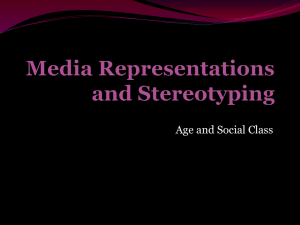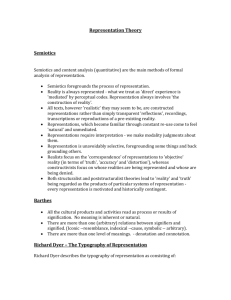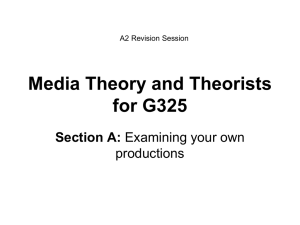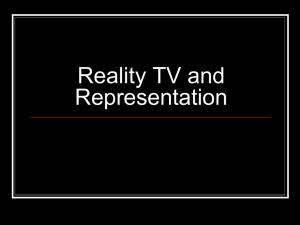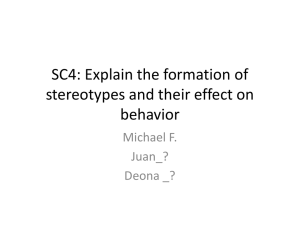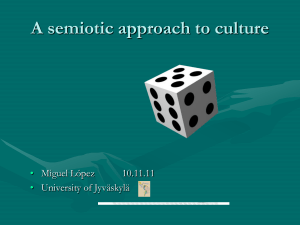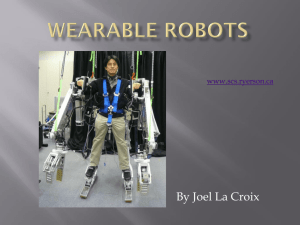Representation
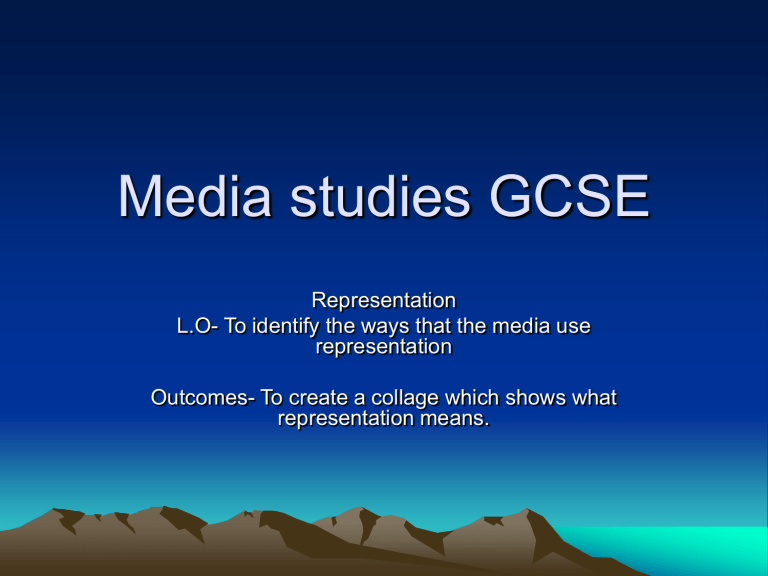
Media studies GCSE
Representation
L.O- To identify the ways that the media use representation
Outcomes- To create a collage which shows what representation means.
In pairs, consider what these pictures reflect
Representation
• Dictionary describes representation as:
• To represent something is to describe, or depict it, to call it up in the mind by description or portrayal.
• To represent also means to symbolise, stand for, be a substitute for- E.G The cross symbolises suffering and the crucifixion of Christ.
What is representation?
• Representation is concerned with the way that people, ideas and events are presented to us.
• This could be representation in magazines, news, soap operas, films and so on.
• It may include representation of people, places, events.
The media
• The media will represent people, places and situations to us
• For example, the people in Eastenders are representing certain groups of people.
• The media rely on the audience understanding these representations and accepting them
• For some people, the medias representation of something may be the only contact that person has with the representation.
• E.g. Representation of Religion
• Teenagers
• Police
As media students, it is important for us to question:
Who is represented (age, gender, class, region, ethnicity, sexuality)
Identifying a lack of representation
Deconstructing how they are represented
(technical and cultural codes) to the audience
Representation
Understanding the difference between what is real and what is represented is vital to our understanding of any media text.
IT IS NOT POSSIBLE
FOR THE MEDIA TO
PRESENT THE WORLD
AS IT REALLY IS
BECAUSE THE MEDIA
CONSTRUCTS
MEANINGS ABOUT THE
WORLD THEY CHANGE
OR MEDIATE WHAT IS
REALLY THERE.
Re-presentation
Things can be described as a representation of things.
So the media, re present the world to the audience. The ideas are a representation of the original
Event ------- Mediated-------re-presentation
Re- presentation
• Describe an event to the person next to you.
• What you achieved was a re-presentation of events.
• You probably left out some details.
• Watching the news is a re-presentation of events. The way in which the show has been edited and the points of the story they pick up, means that it is not possible to represent the story, only re- present it.
For analysis
• Richard Dyer (1983) posed a few questions when analysing media representations in general.
• 1. What sense of the world is it making?
• 2. What does it imply? Is it typical of the world or deviant?
• 3. Who is it speaking to? For whom? To whom?
• 4. What does it represent to us and why? How do we respond to the representation?
Representations of youth
• How do you think youth is presented?
• Watch the following clip and consider if you feel it is a realistic re- presentation of youth
• Waterloo road
Eastenders
• Watch the following clips of Eastenders, what stereotypes do you think are used by the directors?
• Consider the stereotypes used
• How the audience is able to recognise them
• What pleasure the audience may getting form these stereotypes
• http://www.youtube.com/watch?v=cHjfdeV vJP0&feature=channel
• http://www.youtube.com/watch?v=qgUf9hl
TnnU&feature=related
• http://www.youtube.com/watch?v=lMDbkH
T9Hys
And this?
• Consider Dyers questions in response to these photos
Gender
• How do you think gender is re-presented in our society?
• http://www.youtube.com/watch?v=iGoC8FTLKSI
• Difference between men and women
• http://www.youtube.com/watch?v=8rWbg4-dw1g
• Pepsi max
• http://www.youtube.com/watch?v=hGCax1MQi_Q wkd
• http://www.youtube.com/watch?v=qtFgSxed-Oo
• Mccoys
• http://www.youtube.com/watch?v=tO2-VO8bns&feature=related Mccoys
Age
• How is old age re-presented in society?
Stereotypes
• Sometimes representations can turn into stereotypes
• A stereotype is a simplified representation of character, appearance and beliefs.
• A stereotype is a commonly held public belief about specific social groups or types of individuals
• The media may use a stereotype because they are easily recognised by the audience and can convey ideas to the audience
• In a soap opera, what would we stereotype this character to be like?
Blondes
How do the following adverts reinforce stereotypes?
• http://www.youtube.com/watch?v=PDBMH z1Dthw (Cooker advert)
• http://www.youtube.com/watch?v=8z6ks8Z
0X20 (gender stereotyping of women)
Why are correct representations so important?
• People can think negatively about a group of people
• People may use the media representations as the basis for their beliefs
• People may feel they are unfairly represented.
Task
• In a group no bigger than three, create a collage which explains what representation and stereotypes mean
• You will need a definition of both and pictures which reinforce the representations and stereotypes that you decide to focus on
